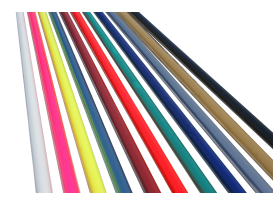
Pultruded Fiber Tubes
1. Manufacturing Process
• Continuous fibers (e.g., glass fiber, carbon fiber) are pulled through a resin bath, then into a heated die for curing and shaping.
• The process is continuous and automated, making it suitable for mass production.
2. Characteristics
• Fiber Orientation: Fibers are primarily aligned axially.
• Strength Properties: High axial strength and stiffness, but relatively low circumferential strength.
• Weight:Generally heavier due to the continuous fiber alignment and resin content.
• Weight:Generally heavier due to the continuous fiber alignment and resin content.
• Shape: Typically straight tubes with fixed cross-sections (e.g., circular, square).
• Production Efficiency: High efficiency with fast production speed.
3. Applications
• Ideal for scenarios requiring high axial strength, such as cable conduits, structural support rods, and long-distance pipelines.
Filament Wound Fiber Tubes
1. Manufacturing Process
• Fibers are impregnated with resin and wound onto a rotating mandrel at specific angles, then cured to form the tube.
• Fiber winding angles can be customized based on design requirements.
2. Characteristics
• Fiber Orientation: Fibers are wound in various directions (axial and circumferential), with adjustable angles.
• Strength Properties: Balanced strength in multiple directions, especially high in both circumferential and axial directions.
• Weight:Relatively lighter because of optimized fiber orientation and efficient use of materials.
• Weight:Relatively lighter because of optimized fiber orientation and efficient use of materials.
• Shape: Typically cylindrical, suitable for structures that need to withstand internal pressure.
• Production Efficiency: Relatively slower, suitable for small to medium production runs.
3. Applications
• Used in applications requiring resistance to internal pressure or multidirectional loads, such as pressure pipelines, gas storage tanks, and chemical storage vessels.
Summary of Differences
• Pultruded Fiber Tubes: Focus on axial strength, suitable for straight structural components, with high production efficiency.
• Filament Wound Fiber Tubes: Emphasize multidirectional strength, ideal for pressurized or complex mechanical conditions, offering greater design flexibility.